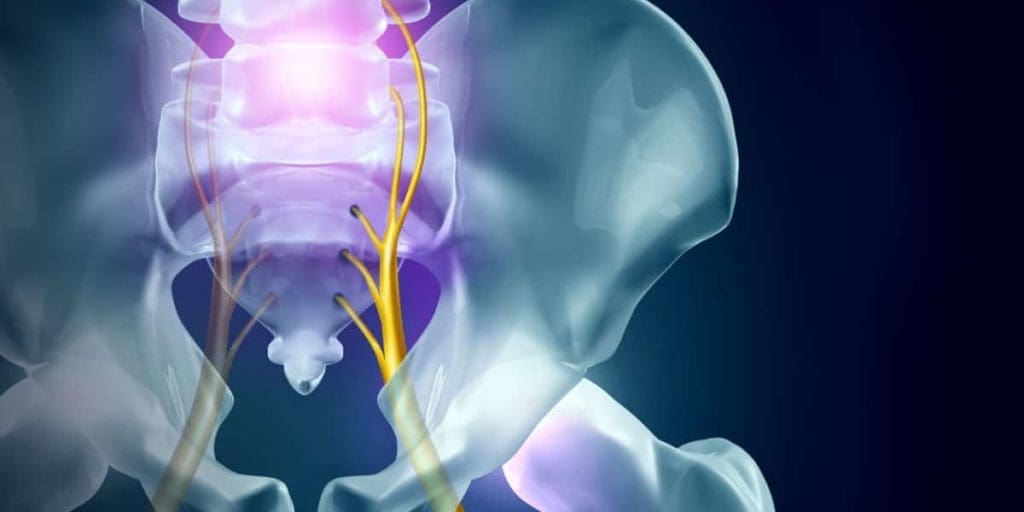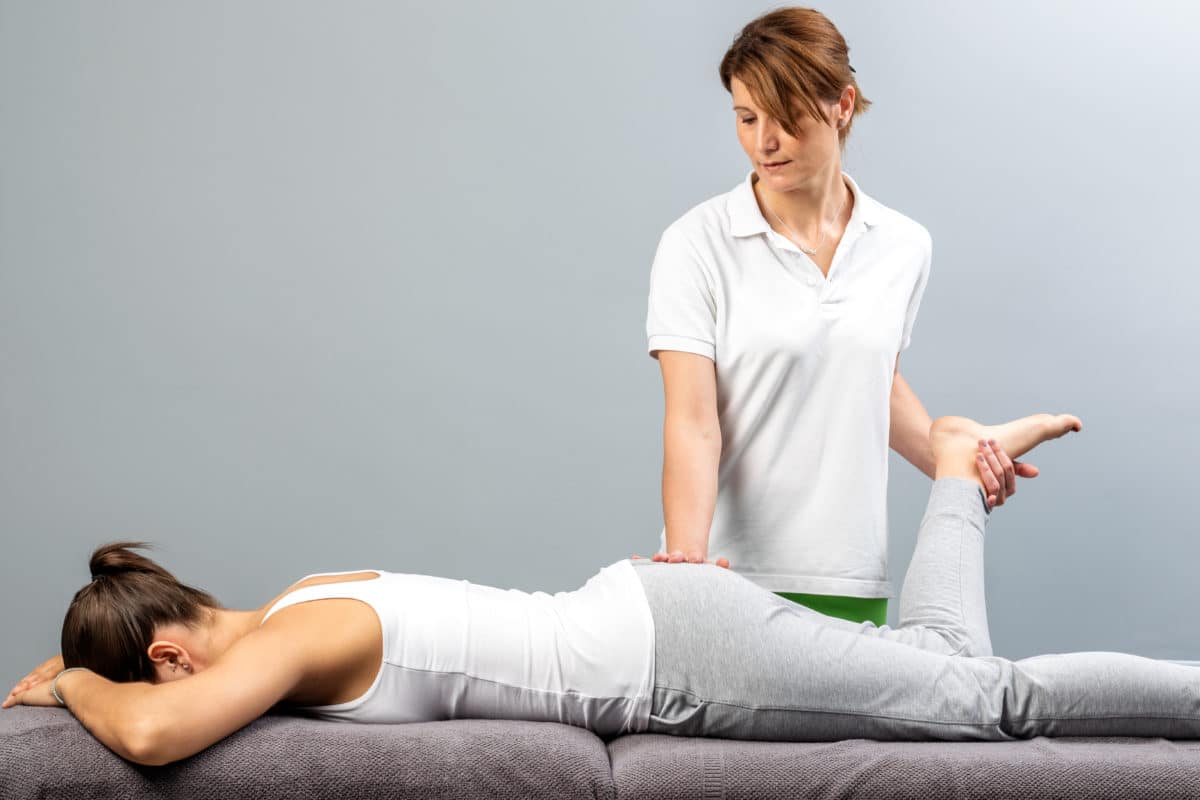Sciatica is a painful condition that causes the sciatic nerve to become inflamed, irritated or pinched. This nerve is the largest single nerve in humans. It affects the entire lower half of the body from your lower back to the bottom of your feet. Let’s look at the causes and at how to treat sciatica symptoms so you can get effective pain relief.
Causes of sciatica
Sciatic nerve pain radiates down through the lower back. It then goes into the leg and is sometimes expressed most intensely as a pain in the hip and/or knee.

People who develop sciatica may experience other conditions such as:
- radiculopathy (or pinched nerves)
- herniated disk
- narrowing of the spinal cord canal
- disc degeneration or degenerative disc disease
- disc slipping
- lumbar spinal stenosis
- bone spurs and fractures
- spine/pelvic injury or scar tissue
- tumors
- spondylolisthesis
- muscle inflammation
- internal bleeding
- obesity
- piriformis syndrome
- trauma that affects the lumbar or gluteal regions (e.g. car accident, etc)
- weak abdominal or thigh muscles that cause undue stress to the lower back
Sciatica symptoms 101
Symptoms vary from person to person and are based on the underlying cause of the condition. Many people feel temporary symptoms for a few hours to a few weeks while others may suffer chronically.
Additionally, some symptoms develop slowly and quietly over time. Some people with sciatica may not even realize the cause of the pain until it becomes severe enough to seek medical advice.
Symptoms of sciatica include:
- throbbing pain is usually in one leg
- pain in the right buttock, hamstring, knee, calf, ankle and/or foot
- both legs may be affected, but most occurrences only affect 1 leg
- weakness is common in the knees and feet
- difficulty in bending the lower joints, bending over and/or lifting heavy objects is also common
- reflexes in the legs may be weak and/or abnormal
- numbness, feelings described as pins and needles, burning sensations in the buttock and leg or throbbing/sharp pains in the hip, knee or ankle are likely to occur
- pain is likely to increase and make it challenging to sit down or to stand up
- pain may graduate in intensity while standing still (walking or moving may temporarily decrease the pain somewhat)
How to diagnose sciatica
When diagnosing sciatica, your doctor will perform a comprehensive exam. This will likely involve tests that check the alignment of your spine, the strength of your knees and your reflex, motion and extremity sensitivity.
Your doctor may use x-rays or other imaging tests to identify the cause of your condition. She may also use these tests to check for spinal disc abnormalities. Once your diagnosis is established, treatment can begin.
There is no cure for sciatica. However, there are many standard and alternative treatments to help reduce pain and accelerate healing.
If you’re starting to notice pain or numbness in your lower body, watch this video on how to check for sciatic pain at home:
How to treat your sciatica symptoms
Sciatica has, in most cases, a way of healing itself. It’s different from other types of pain because of the bodies’ abilities to “reabsorb the disc material that is causing symptoms.” This means that keeping up with a consistent level of activity is crucial to managing – and reducing – the pain.

You may need brief periods of rest to help you manage it. However, it’s likely that your doctor will ask you to be as active as possible and to avoid long periods of rest. Talk to your doctor about these techniques to inspire your back to recuperate and to prevent the pain from returning:
- brief bed rest and simple at-home pain treatments such as cold packs or heating pads (couple the use of heating pads with pre-stretching exercises and then ice packs afterward for optimal results)
- over-the-counter NSAIDs
- prescription anti-inflammatory drugs, pain relievers and muscle relaxers, including cortisone injections and epidurals
- specialized laser treatments
- simple exercise or yoga (start out 10 – 20 minutes at a time and work your way up)
- acupuncture
- chiropractic alignment
- physical therapy (in many cases, it is covered by insurance) and/or spinal decompression or surgical procedures to correct spinal conditions (usually only in cases of tumor removal or repair of fractured/injured vertebrae)
- stress relief techniques and/or psychological training (stress is often linked to worsening pain)
- avoiding heavy physical activity such as heavy lifting, running or any motion that twists or jerks the spine (talk to your health care team about recommended light stretches you can perform at home a few times a day instead)
Share this video with a loved one who is struggling with sciatica:
What questions do you have about how to treat sciatica symptoms?
What topics related to treating sciatica would you like to see us explore?
Email us at info@painresource.com with your ideas.
Are you on Facebook?
Join our online community by clicking here.
Pain management starts and ends with health awareness and dedication. Click here to read more.
No information in this article should be used to diagnose, treat or medicate any condition. If you are experiencing any of these symptoms and you feel like sciatica could be the cause, please seek the professional medical advice of your primary care physician and/or physical therapist.


Hola Susan
Exelente su articulo y le tengo una consulta..
Yo sufri de una estenosis Lumbar y me realizaron 3 operaciones en la espalda Lumbar, eso fue hace 5 años, pero el resultado de las misma es que no tengo una perfecta locomocion, por el hecho que los tobillos y la rodilla de la pierna derecha me quedaron debiles, por el hecho que el nervio ciático que se ramifica por la pierna derecha han constracturado los músculos de esa pierna, además de causar un pie caído que voy recuperando poco a poco. Que me recomiendas para obtener el 100% de movilidad en estos miembros y poder hacer vida deportiva como lo hacia anteriormente. Espero tus comentarios.. Saludos
Hello Martin and thank you for the comment.
Aside from what is in the article, we can not offer any other advise that your doctor should be providing.
We do however have other articles that may also help if you have not seen them yet?
https://painresource.com/sciatica/5-sciatica-yoga-stretches-for-back-pain-relief/
https://painresource.com/sciatica/coping-with-sciatica-in-the-workplace/
https://painresource.com/sciatica/athletes-with-sciatica-beat-chronic-pain/
Hope these help!